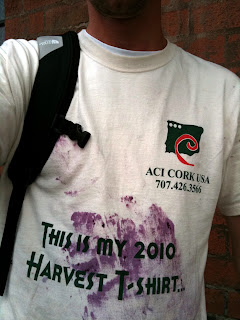Making [good] red wine requires that you use one of two techniques to keep the juice in contact with the grape skins: Punch Downs or Pump Overs.
Our sister winery uses pump overs and closed fermentation tanks. That means that juice is collected from the bottom of the tank and pumped over the top so that it can keep the skins moist (skins rise to the top as must is fermenting into wine). As the juice filters down through the skins, it takes on more color, flavor, tannins, etc.
We use a different technique. Our fermentation tanks are open at the top, and we also ferment wine in bins. Fermenting in bins allows you to break up the crushed fruit into small 110-gallon batches. We can then use different strains of yeast in different bins, and make simple adjustments during the fermentation process (add water, add finishing yeasts, etc.). With bins or tanks the skins must be "punched down" to the bottom of the tank/bin. Here's a video that shows some skins being punched:
Punch downs are done every few hours. Multiply that by 20 - 30 bins and several large tanks, and you get an idea of how much work goes into your wine.
Once the skins have been punched down, we have to wipe the edges of the tanks/bins. If there's any juice or grape chunks fermenting on the edges of the container, it's an opportunity for some sort of contamination (foreign yeast strain, mold, fungus, etc.), and that's not good. Cleanliness is important:
Once the edge of the container is clean, we add a little bit of dry ice to tanks or bins that have not yet been inoculated with yeast. Dry ice vaporizes into gaseous CO
2, and since CO
2 is heavier than air it forms a nice protective layer between the must and the top of the bin/tank. It halts any sort of fermentation that might have begun due to naturally-occurring yeast from the grapes.
We then place a cover on the tank/bin and wait until the next scheduled punch down. Then we repeat the whole process at 8:00 am, 10:30 am, 12:00 pm, 2:30 pm, and 4:00 pm.
Once we add yeast to a tank/bin, we no longer add dry ice after a punch down. The must starts getting warm as the yeast digests the sugars and creates alcohol. The juice and skins separate, the skins rise to the top, and a cap forms on the must. Here's what the cap looks like (you can see that it's thicker, stickier, and breaks up in chunks):
The yellow powder in the middle of the bin is a fermentation aid that helps yeast finish the fermentation process. Yeast gets "tired" after several days of fermentation and needs a little extra food. You can also see bubbles/foam form when the must is stirred. That's CO2 being released, as it's a byproduct of fermentation (that's why your beer is bubbly).
























